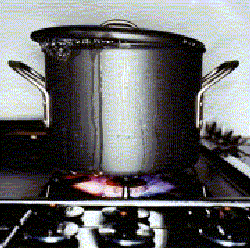One-Way Heat Traffic

Heat normally flows through an object from hot to cold, no matter how it’s oriented. Electric current, on the other hand, can be restricted to one-way flow, as in a rectifier or diode. The 4 March print issue of PRL describes a simple thermal rectifier that might be built from strands of DNA or other unusual materials. According to the researchers’ computer simulations, a crystal lattice whose atoms vibrate in the right way could be worked into a thermal rectifier and perhaps even thermal transistors. Such devices could be useful in both electronics and biotechnology.
The basic theory of heat flow relies upon some simple assumptions at the microscale, such as the idea that atoms vibrate as though they are connected to ideal springs. But researchers would like to better understand how the macroscopic laws of heat arise from the behaviors of real atoms. One hope, says Giulio Casati of Insubria University in Como, Italy, is that with current computational tools, “we can go inside, look at the motion of single atoms and molecules and therefore, at least in principle, control the heat flow.”
Casati and his colleagues studied heat flow through a solid by simulating a chain of oscillating particles–essentially, a one-dimensional crystal. Identical ideal springs vibrate at the same frequency, regardless of their amplitude, so motion (heat) at one end of the chain is easily transmitted down the line, until the temperature is uniform. But if the springs are “anharmonic,” their vibration frequency depends on the amplitude, so motion (and therefore heat energy) is transmitted less efficiently. Team member Michel Peyrard of Ecole Normale Supérieur in Lyon, France, says there are indications that such behavior occurs in DNA molecules.
To make a rectifier, the researchers considered an anharmonic chain sandwiched between two harmonic caps, one with stiff springs–which vibrate at higher frequencies–and the other with more pliable springs. For a large amplitude vibration (high temperature), the atoms in the middle section jiggle slower, and they’re more likely to be in synch with the pliable end. At colder temperatures, the anharmonic chain communicates better with the stiff end. So if the flexible end is given larger oscillations, these shimmy down the line, getting smaller but faster, and heat is transmitted to the stiff end–albeit with imperfect efficiency. But heating the stiff cap forces the anharmonic chain to vibrate at large amplitude and high frequency, which it cannot do well, so the heat flow is inhibited, according to the simulations.
The authors say their result depends on very general principles, so it should apply to three dimensions as well. Peyrard says experimentalists might build a rectifier from DNA or from a “nanostructured” material, constructed one molecule at a time. He imagines that thermal devices could reroute excess heat in a microchip and that a series of thermal transistors might run a microscale “lab-on-a-chip,” where temperature controls biochemical reactions.
The new research is stimulating, says David Campbell of Boston University. Though the basic ideas appear to work in three dimensions, engineers will face some challenges fashioning real compounds into such devices, he says. Campbell sees great strides in the development of new types of crystals, but “I don’t think you’re going to see a thermal rectifier in the Sharper Image catalog next year.”
–JR Minkel
JR Minkel is a freelance science writer in New York City.


